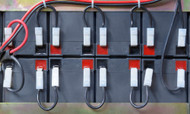Series vs. Parallel Batteries: What Are the Differences?
Posted by GMI Energy on Mar 08, 2023
Are you looking for the ideal power configuration for your equipment and devices? Luckily, our team at GMI Energy Products has the ultimate resources for you! Read on to learn the key differences between series and parallel batteries, as well as the notable applications and benefits of each type of connection.
Series Batteries
Series batteries are a collection of two or more connected battery devices. This type of connection combines the voltage output of all batteries, increasing the overall power capabilities. For example, two 12-volt batteries connected in a series boast a result of 24 volts. You can only connect batteries in a series if they feature the same voltage and capacity rating. Configuring two or more different batteries with a series connection may damage the device and the batteries themselves.
Parallel Batteries
Parallel configurations are similar to series batteries and entail two or more connected batteries. However, connecting batteries in parallel does not increase the voltage output. Instead, this type of connection boosts amp-hour capacity to improve the battery's lifespan. For example, two 12-volt 50Ah batteries connected in parallel retain a voltage output of 12 volts and an amp-hour of 100Ah! To achieve an ideal parallel configuration, match the positives and negatives of one battery to the adjacent battery. Repeating these connections creates a more durable power source.
The Differences: Benefits & Applications
Connecting batteries in series increases overall voltage, while parallel batteries boost amp-hour capacity. How does that help you? Let's break down the differences between these two battery configurations by exploring each option's key benefits and applications.
Series batteries are ideal when powering an energy-demanding machine or device. Instead of investing in massive batteries, you can wire multiple in a series and enhance the overall voltage. As a helpful bonus, increasing the voltage capacity of your batteries reduces the system amperage required, allowing you to utilize smaller wires without having voltage drop or heat issues throughout your cables and connections. Series batteries also charge exceptionally fast compared to parallel counterparts.
Parallel batteries have plenty of benefits and applications. Primarily, the enhanced amp-hour capacity ensures a more durable, long-lasting power source for your equipment and devices. Additionally, connecting batteries in parallel is often more straightforward for the average individual. You can certainly opt for a more complex, parallel/series connection that increases both amp-hour capacity and voltage output!
Understanding the differences between series and parallel batteries ensures you make the right decision when ordering power units for your equipment. Check out our selection of high-quality lithium batteries at GMI Energy today!

